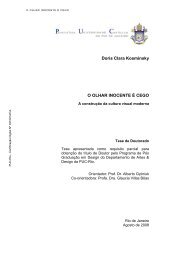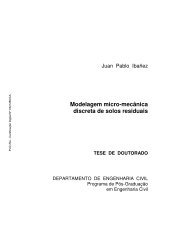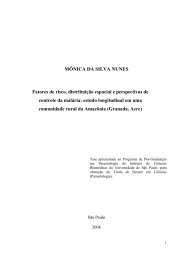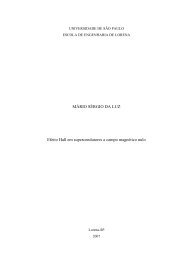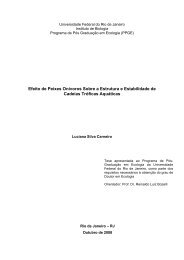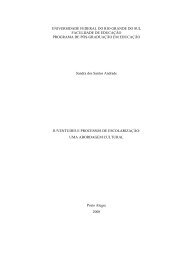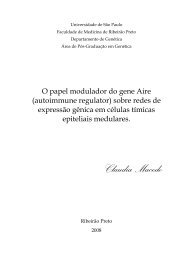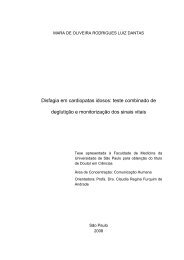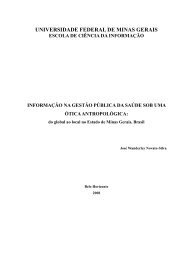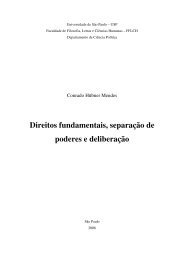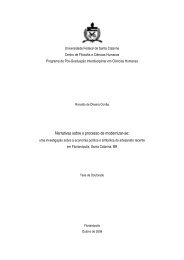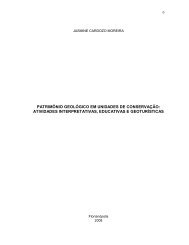Table 1Thermal and optical properties of compounds 3a–eThermal propertiesOptical propertiesTransitions/1C a T g /1C b T dec. /1C c CompoundsSol. d Film Sol. d FilmeF Fl E g /eV fAbs. l max /nm Fl. l max /nm3a C 278.0 I — 400 290 290 360 363 0.25 3.93b C 129.9 I 55.4 445 294 288 362 366 0.33 3.93c C 93.8 I 46.7 437 294 287 362 368 0.33 3.93d C 86.6 I 70.3 441 294 286 362 371 0.34 3.93e C 92.2 (19.3) Col h 207.6 (6.8) I — 436 311 316 387 388 0.47 3.5a First heating scan (DSC). C: crystal; Col h : hexagonal columnar phase; I: isotropic liquid. (DH/kJ mol1 ). b Second heating scan (DSC). c Onsetof decomposition under N 2 (TGA). d CHCl 3 solution (10 5 mol L 1 ). e Relative to the PBD (F Fl = 0.83) 7 . f Determined from absorption spectraof the films.clearly in a non-planar conformation with respect to thetriazine core. The mean plane angles for the twist of the ringsB, C and D from the central ring A are 19.3(1), 28.7(1) and61.8(1)1, respectively. Molecular packing is mainly due tovan der Waals interactions, which is in agreement with thesoftness of the crystals, and also due to dipolar interactions(calculated dipole moment is 2.0 D, with a large component(1.8 D) perpendicular to the tristriazolotriazine core). Molecularp-stacking is sterically inhibited in the solid phase, whichimproves the potential for these materials to be applied asgood solid state emitters, since the formation of excimers viap-stacking is known to suppress the emission in solids. 8B3LYP/6-311G(d,p) calculations 9 (see ESIw) for compound3a corroborated the observed non-planar conformations andthe structural parameters were in excellent agreement with thecrystallographic data. Conformational analysis of one phenylgroup yielded 11.5 kJ mol1 for the barrier to internal rotationof a single phenyl group. This value is quite small, thusallowing a conformational equilibrium to be attained quicklyat room temperature and, thus, a symmetric structure can beexpected in solution in the NMR time scale. In fact, symmetricstructures in the 1 H, 13 C and 15 N NMR spectra of the finalcompounds were found.The thermal and optical properties of compounds 3a–e aresummarized in Table 1. They are thermally stable compoundsas shown by their high decomposition temperatures (4400 1C)according to TGA measurements. Except for 3a, these compoundsdo not show tendencies towards crystallization, whichis further evidence of non-aggregation in the solid state. Aftermelting, compounds 3a–d do not crystallize upon cooling andthe obtained transparent films remain stable for months withoutany crystallization. Upon heating, the second DSC scan ofthese compounds reveals only one glass transition temperature(see ESIw). It was observed that increasing the length of thealiphatic chains leads to a decrease in the melting point andimproves the film forming behavior. Compound 3e, with sixperipheral aliphatic chains, is an interesting discotic liquidcrystal exhibiting a very wide hexagonal columnar phase(Col h ) from 92.2 to 207.6 1C. The mesophase was assignedas Col h on the basis of the typical pseudo focal conic texturesobserved by polarized optical microscopy on cooling (Fig. 2)and confirmed by X-ray diffraction (see ESIw). The cell parametera was calculated to be 30.4 A˚ , smaller than the van derWaals diameter of the molecule (43.0 A˚ ) in the most extendedconformation. This indicates either interdigitation or partialfolding of the chains. The core–core mean distance was foundto be 3.5 A˚ , suitable for p-stacking. In addition, similarities inthe optical textures were observed at temperatures above andbelow the melting point, indicating the retention of a columnarstructure in the low temperature phase.As a consequence of this amorphous behavior, stable spincoatedfilms are easily obtained on quartz plates from theirrespective CHCl 3 solutions. UV and fluorescence spectra werethen measured in solution and in solid films (Fig. 3).The maximum absorption wavelengths for compounds 3a–ein solution and in the film are quite similar, peaking at around290–311 nm (e B 50 000 L mol1 cm 1 ) and 286–316 nm,respectively. These are attributed to the p–p* transitions in theheteroaromatic portion of the molecule due to the high molarabsorption coefficient.The INDO/S-CIS calculated electronic spectrum 10 for a nonplanarconformation of compound 3a is in better agreementwith the experimental data than that calculated for the planarconformation (see ESIw). The band at 290 nm involves twotransitions (calculated at 295 nm), each one involving mainlyHOMO–LUMO and HOMO–LUMO+1 orbitals. The nearesttransitions to this main band occur at B 280 nm with very lowoscillator strength values and involve very high energy unoccupiedmolecular orbitals. Thus, the observed band has only twocontributions whose molecular orbitals are illustrated in Fig. 4.These compounds show strong blue fluorescence in solutionwith maximum emission wavelengths between 360 and 387 nmand fluorescence quantum yields (F Fl ) varying from 25 to 47%(Table 1). They also showed strong fluorescence in the solid phase,exhibiting emission maxima at wavelengths between 363 and390 nm, with very small red-shifts compared to those in solution.Fig. 2 Polarizing optical photomicrographs of pseudo focal conictexture of Col h for 3e obtained at 205 1C (left) and 202 1C (right) oncooling.This journal is c The Royal Society of Chemistry 2008 Chem. Commun., 2008, 5134–5136 | 5135
In summary, we performed the synthesis and structural, thermaland optical characterization of new tris[1,2,4]triazolo[1,3,5]-triazines. Non-planar conformational structures led to good solidemitter and film forming behavior. In addition, a discotic liquidcrystal was built with this center possessing a very stable Col hphase with a temperature range wider than 115 1C. Interestingly,these compounds present a high thermal stability associated withfilm forming behavior. The theoretical calculations were in goodagreement with the experimental observations, corroboratedspectral assignments and provided information on the structuraland optical behavior at the electronic/molecular level.Financial support from Conselho Nacional de DesenvolvimentoCientı´fico e Tecnolo´gico (CNPq, PRONEX, FAPESC)is gratefully acknowledged. The authors are grateful to MrsMarly Soldi (DSC and TGA measurements), Dr FernandoHalwass ( 15 N NMR measurements), Dr Gustavo A. Micke(MS spectra) and Dr Haidi Fiedler and Dr Edson Minatti forfree access to the photophysical instruments. We also thankthe reviewers for their helpful and interesting suggestions.Notes and referencesFig. 3 Absorption and fluorescence spectra of 3a–e in solution (a)and film (b).Fig. 4HOMO and LUMOs at the INDO/S level.Fluorescence spectra of compound 3e in the Col h phase showedthe same maximum wavelength (388 nm) but with a significantdecrease (about 25%) in the curve area, compared to the emissionin the solid phase (see ESIw). This is indicative of a larger extent ofself-quenching aggregates 2d in the liquid crystal phase, consistentwith the intracolumnar distance (3.5 Å) observed by XRDanalysis. The energy gap between HOMO and LUMO (E g )wasobtained from solid phase absorption spectra according to thepublished method. 11 The optical E g values were found to be ashigh as 3.5 eV in 3e and around 3.9 eV in 3a–d. Electrochemically,compound 3a, used as a representative case, exhibited only anirreversible oxidation wave peaking at 1.6 V vs. SCE (see ESIw),suggesting that the tristriazolotriazine core potentially has electron-transportingcharacteristics. Thus, the HOMO energy wasobtained from the oxidation potential 12 corresponding to 5.8 eV.The LUMO was found to be 1.9 eV, by subtracting its opticalband gap from the HOMO value. These high band gap valuescharacterize these compounds as wide gap, blue emitting materials,which is advantageous since it indicates that they can beapplied as hosts in electroluminescent devices. 13z Crystal data: formula C 27 H 21 N 9 O 3 ; FW 519.53; crystal system:triclinic, space group P 1, T = 293 K, a = 6.418(3), b = 12.867(2),c = 14.500(9) Å, a = 80.73(2), b = 86.34(5), g = 89.67(3)1, V =1179.4(9) Å 3 , Z =2,D calc = 1.463 Mg m 3 , m = 0.101 mm 1 ; uniquereflections = 4194 (R int = 0.0462); parameters = 353; GOOF (F 2 )=1.026; R 1 [I 42s(I)] = 0.0642, wR 2 (all data) = 0.1834.1 S. Laschat, A. Baro, N. Steinke, F. Giesselmann, C. Hägele, G.Scalia, R. Judele, E. Kapatsina, S. Sauer, A. Schreivogel and M.Tosoni, Angew. Chem., Int. Ed., 2007, 46, 4832.2(a) S. Sergeyev, W. Pisula and Y. H. Geerts, Chem. Soc. Rev., 2007,36, 1902; (b) S. Xiao, M. Myers, Q. Miao, S. Sanaur, K. Pang, M.L. Steigerwald and C. Nuckolls, Angew. Chem., Int. Ed., 2005, 44,7390; (c) B.Go´mez-Lor, B. Alonso, A. Omenat and J. L. Serrano,Chem. Commun., 2006, 5012–5014; (d) H. F. Hsu, M. C. Lin, W. C.Lin, Y. H. Lai and S. Y. Lin, Chem. Mater., 2003, 15, 2115.3(a) R. Cristiano, D. M. P. O. Santos and H. Gallardo, Liq. Cryst.,2005, 32, 7;(b) Y. D. Zhang, K. G. Jespersen, M. Kempe, J. A.Kornfield, S. Barlow, B. Kippelen and S. R. Marder, Langmuir,2003, 19, 6534; (c) A. J. Attias, C. Cavalli, B. Donnio, D. Guillon,P. Hapiot and J. Malthête, Chem. Mater., 2002, 14, 375; (d) M.J.Sienkowska, J. M. Farrar, F. Zhang, S. Kusuma, P. A. Heiney andP. Kaszynski, J. Mater. Chem., 2007, 17, 1399.4 R. Huisgen, H. V. Sturm and M. Seidel, Chem. Ber., 1961, 94,1555.5 V. A. Tartakovsky, A. E. Frumkin, A. M. Churakov and Y. A.Strelenko, Russ. Chem. Bull., 2005, 54, 719.6 The aryltetrazoles were prepared as described in: H. Gallardo, R.Magnago and A. J. Bortoluzzi, Liq. Cryst., 2001, 28, 1343.7 V. N. Salimgareeva, R. M. Polevoi, V. A. Ponomareva, N. S.Sannikova, S. V. Kolesov and G. V. Leplyanin, Russ. J. Appl.Chem., 2003, 76, 1655.8 J. N. Moorthy, P. Natarajan, P. Venkatakrishnan, D. F. Huangand T. J. Chow, Org. Lett., 2007, 9, 5215.9 A. D. Becke, J. Chem. Phys., 1993, 98, 5648; C. Lee, W. Yang andR. G. Parr, Phys. Rev. B, 1988, 37, 785; P. J. Stephens, F. J. Devlin,C. F. Chabalowski and M. J. Frisch, J. Phys. Chem., 1994, 98,11623.10 J. Ridley and M. C. Zerner, Theor. Chim. Acta,1973,32,111;M.C.Zerner, G. H. Loew, R. F. Kichner and U. T. Mueller-Westerhoff,J. Am. Chem. Soc., 1980,102, 589.11 R. Cristiano, E. Westphal, I. H. Bechtold, A. J. Bortoluzzi and H.Gallardo, Tetrahedron, 2007, 63, 2851.12 J. L. Brédas, R. Silbey, D. S. Boudreaux and R. R. Chance, J. Am.Chem. Soc., 1983, 105, 6555.13 M. L. Lee, H. H. Chen, C. H. Liao and C. H. Tsai, Appl. Phys.Lett., 2004, 85, 3301.5136 | Chem. Commun., 2008, 5134–5136 This journal is c The Royal Society of Chemistry 2008
- Page 2 and 3:
AUTOBIOGRAFIARodrigo Cristiano nasc
- Page 5 and 6:
Rodrigo CristianoMATERIAIS MOLECULA
- Page 7 and 8:
À minha esposa Cláudia.
- Page 9 and 10:
VÍNDICEINTRODUÇÃO ..............
- Page 11 and 12:
VIILISTA DE FIGURASFigura 1. Proces
- Page 13 and 14:
IXFigura 31. Espectro de RMN de 1 H
- Page 15 and 16:
XIFigura 63. Espectros de (a) UV e
- Page 17 and 18:
XIIILISTA DE TABELASTabela 1. Os ti
- Page 19 and 20:
XVTGA - Análise termogravimétrica
- Page 21 and 22:
XVIIABSTRACTThe synthesis and chara
- Page 23 and 24:
Introdução 19A química orgânica
- Page 25 and 26:
Introdução 21fenômenos possuem t
- Page 27 and 28:
Introdução 23elétrico é aplicad
- Page 29 and 30:
Introdução 25(Figura 3). A verdad
- Page 31 and 32:
Introdução 27investigar a conexã
- Page 33 and 34:
Introdução 29com um banco de dado
- Page 35 and 36:
Introdução 31descrever a estrutur
- Page 37 and 38:
Introdução 33Nas fases esméticas
- Page 39 and 40:
Introdução 35OHC 6 H 13OOOC 11 H
- Page 41 and 42:
Introdução 37O interesse na sínt
- Page 43 and 44:
Introdução 39Figura 17. Represent
- Page 45 and 46:
Introdução 41Figura 19. Esquema d
- Page 47 and 48:
Introdução 43mais comum nesses ma
- Page 49 and 50:
Introdução 45formam estruturas su
- Page 51 and 52:
Introdução 47do material quando n
- Page 53 and 54:
Introdução 491,3,4-oxadiazolN NOO
- Page 55 and 56:
Introdução 51R 2 OR 1OR 2N N ONON
- Page 57 and 58:
Introdução 53estável através de
- Page 59 and 60:
RESULTADOS EDISCUSSÃO
- Page 61 and 62:
Resultados e Discussão 57aromátic
- Page 63 and 64:
Resultados e Discussão 59Esquema 3
- Page 65 and 66:
Resultados e Discussão 61mantendo-
- Page 67 and 68:
Resultados e Discussão 63(ν C≡C
- Page 69 and 70:
Resultados e Discussão 65funcional
- Page 71 and 72:
Resultados e Discussão 67ROORROOO4
- Page 73 and 74:
Resultados e Discussão 69Uma rota
- Page 75 and 76:
Resultados e Discussão 71baNNOc d
- Page 77 and 78:
Resultados e Discussão 73Tabela 3.
- Page 79 and 80:
Resultados e Discussão 75Para o co
- Page 81 and 82:
Resultados e Discussão 77porque o
- Page 83 and 84:
Resultados e Discussão 795. CLs cu
- Page 85 and 86:
Resultados e Discussão 81gerado a
- Page 87 and 88:
Resultados e Discussão 835.2. Prop
- Page 89 and 90:
Resultados e Discussão 85(a)Cr-CrC
- Page 91 and 92:
Resultados e Discussão 87(a)(b)Fig
- Page 93 and 94:
Resultados e Discussão 89Esses com
- Page 95 and 96:
Resultados e Discussão 91catalíti
- Page 97 and 98:
Resultados e Discussão 93a complet
- Page 99 and 100:
Resultados e Discussão 95A banda l
- Page 101 and 102:
Resultados e Discussão 97constante
- Page 103 and 104:
Resultados e Discussão 99A não-pl
- Page 105 and 106:
Resultados e Discussão 101(a)(b)T
- Page 107 and 108:
Resultados e Discussão 103(e)trans
- Page 109 and 110:
Resultados e Discussão 1056.5. Pro
- Page 111 and 112:
Resultados e Discussão 107composto
- Page 113 and 114:
Resultados e Discussão 109composto
- Page 115 and 116:
Resultados e Discussão 1117. Tris-
- Page 117 and 118:
Resultados e Discussão 113Esquema
- Page 119 and 120:
Resultados e Discussão 115A caract
- Page 121 and 122:
Resultados e Discussão 117ppm rela
- Page 123 and 124:
Resultados e Discussão 1197.2. Est
- Page 125 and 126:
Resultados e Discussão 121Figura 7
- Page 127 and 128:
Resultados e Discussão 123N21-N22
- Page 129 and 130:
Resultados e Discussão 125método
- Page 131 and 132:
Resultados e Discussão 127após lo
- Page 133 and 134:
Resultados e Discussão 129baseado
- Page 135 and 136:
Resultados e Discussão 131aquecime
- Page 137 and 138:
Resultados e Discussão 133composto
- Page 139 and 140:
Resultados e Discussão 1357.5. Est
- Page 141 and 142:
Resultados e Discussão 137estabili
- Page 143 and 144:
Conclusões 1398. CONCLUSÕESEm ger
- Page 145 and 146:
SEÇAO EXPERIMENTAL
- Page 147 and 148:
Seção Experimental 143respectivam
- Page 149 and 150:
Seção Experimental 1457,08 (m, 2H
- Page 151 and 152:
Seção Experimental 147K 2 CO 3 (7
- Page 153 and 154:
Seção Experimental 149H, -CH 2 NC
- Page 155 and 156:
Seção Experimental 1512918, 2851,
- Page 157 and 158:
Seção Experimental 153Esse compos
- Page 159 and 160:
Seção Experimental 155Espectro de
- Page 161 and 162:
Seção Experimental 157Este compos
- Page 163 and 164:
Seção Experimental 159H 21 C 10 O
- Page 165 and 166:
Seção Experimental 16114,36; 22,9
- Page 167 and 168:
Seção Experimental 163H), 6,85 (d
- Page 169 and 170:
Seção Experimental 165NCNCNNHO59O
- Page 171 and 172:
Seção Experimental 167H 21 C 10 O
- Page 173 and 174:
Seção Experimental 169(sílica-ge
- Page 175 and 176:
Seção Experimental 171dodeciloxib
- Page 177 and 178:
Seção Experimental 173NCNCNNOOOOC
- Page 179 and 180:
Seção Experimental 175Análise el
- Page 181 and 182:
Seção Experimental 177Espectro de
- Page 183 and 184:
Seção Experimental 179131,6; 132,
- Page 185 and 186: Seção Experimental 181Espectro de
- Page 187 and 188: Seção Experimental 183fornecendo
- Page 189 and 190: Seção Experimental 185Espectro de
- Page 191 and 192: Referências bibliográficas 18710.
- Page 193 and 194: Referências bibliográficas 189pha
- Page 195 and 196: Referências bibliográficas 19149.
- Page 197 and 198: Referências bibliográficas 19371.
- Page 199 and 200: Referências bibliográficas 19596.
- Page 201 and 202: Referências bibliográficas 197120
- Page 203 and 204: 382 R. Cristiano et al.acetylenes 1
- Page 205 and 206: 384 R. Cristiano et al.Scheme 2. Re
- Page 207 and 208: 386 R. Cristiano et al.Table 3. Sum
- Page 209 and 210: 388 R. Cristiano et al.117.0-125.4u
- Page 211 and 212: 390 Hockey stick-shaped LC compound
- Page 213 and 214: LSYC146630 LSYC_036_007 Techset Com
- Page 215 and 216: LSYC146630 LSYC_036_007 Techset Com
- Page 217 and 218: LSYC146630 LSYC_036_007 Techset Com
- Page 219 and 220: LSYC146630 LSYC_036_007 Techset Com
- Page 221 and 222: 998 R. Cristiano et al.block contai
- Page 223 and 224: 1000 R. Cristiano et al.(a)(b)Figur
- Page 225 and 226: 1002 R. Cristiano et al.4.3.2. 1-(4
- Page 227 and 228: Tetrahedron 63 (2007) 2851-2858Synt
- Page 229 and 230: R. Cristiano et al. / Tetrahedron 6
- Page 231 and 232: R. Cristiano et al. / Tetrahedron 6
- Page 233 and 234: R. Cristiano et al. / Tetrahedron 6
- Page 235: COMMUNICATIONwww.rsc.org/chemcomm |



